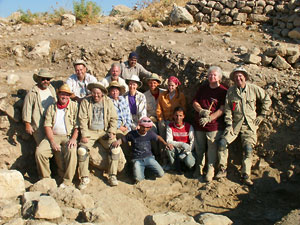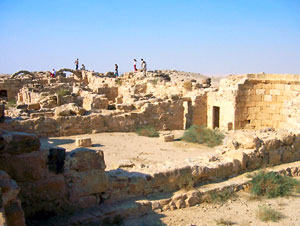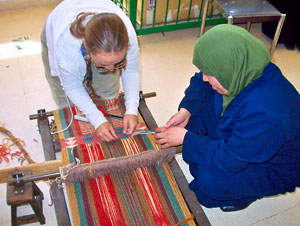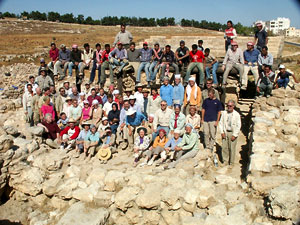Weekly Reports from Jordan
Choose Year: or Choose week
New Horizons
Larry G. Herr and Douglas R. Clark
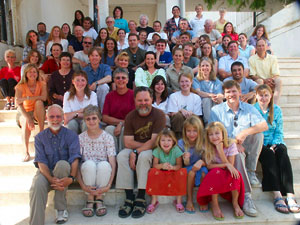 We diggers are very aware that our work is destruction. Every time we excavate into an ancient city we destroy part of that world, because we can never put it back the way we found it. That's why we keep meticulous records, draw everything we find, and take photos every day. But sometimes the destruction creates another view of the site. That's what happened in several locations this last week.
We diggers are very aware that our work is destruction. Every time we excavate into an ancient city we destroy part of that world, because we can never put it back the way we found it. That's why we keep meticulous records, draw everything we find, and take photos every day. But sometimes the destruction creates another view of the site. That's what happened in several locations this last week.
In Field A (Bob Bates, supervisor) several walls were removed after being exposed for years by our previous excavations, creating a definitely different look. 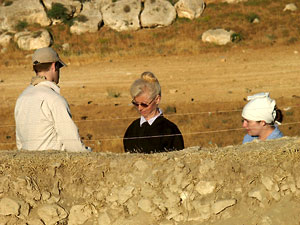 John Lawlor, the long-time former supervisor of the field, would not recognize his old stomping ground. Balks were also removed, lending a different look to the field. Teams from just about the whole field removed significant walls: Tom Venner, Kassie Skoretz, Heather Merizan, Caroline Houghton, Myron Widmer, Steve Salcido, Debra Haberman, Christina Widmer, Aaron Davis, Brenda Adams, Amy Bellinghausen, and Tyler Mitchell.
John Lawlor, the long-time former supervisor of the field, would not recognize his old stomping ground. Balks were also removed, lending a different look to the field. Teams from just about the whole field removed significant walls: Tom Venner, Kassie Skoretz, Heather Merizan, Caroline Houghton, Myron Widmer, Steve Salcido, Debra Haberman, Christina Widmer, Aaron Davis, Brenda Adams, Amy Bellinghausen, and Tyler Mitchell.
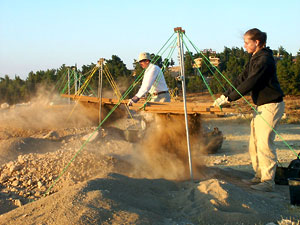 That meant that we pounded countless boulders with sledge hammers in order to break them up into small enough pieces to carry out of the squares. Chips flew and the metallic ping of hammer on stone was a constant sound. One local worker was hit in the eye by a chip and promptly treated (successfully) by physician Nerida Bates and nurse Carolyn Waldron.
That meant that we pounded countless boulders with sledge hammers in order to break them up into small enough pieces to carry out of the squares. Chips flew and the metallic ping of hammer on stone was a constant sound. One local worker was hit in the eye by a chip and promptly treated (successfully) by physician Nerida Bates and nurse Carolyn Waldron.
The other team in Field A (Audrey Shaffer, Erica Hufnagel, and Derek Bobst) began to expand their deep probe to intersect the line of a wall we suspect may be part of the city gate. But there are strong signs that the roadway for the gate we hope to find may be very deep.
In Field B (Kent Bramlett, supervisor) one team (Carolyn Waldron, Anneliese Weiss, and Katie Van Petten) removed an Iron 2 wall from about 600 BC in order to get at the outer wall of the great Late Bronze Age Palace/Temple from about 1400 BC. At the same time they dismantled a balk, providing new vistas to the north outside the field.
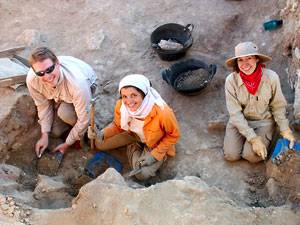 Rather than providing new vistas, the other teams in Field B concentrated on digging deeper to find the floor of the palace/temple. The first to find it were Ellen Bedell and Bethany Reiswig, followed quickly by Janelle Worthington, Matt Vincent, and Lindsey Hill. Strangely, they have found large amounts of unburned bones, including many jawbones of sheep and goats on the floor. Lots of burned wooden beams fallen from the ceiling of the room appeared, as well. But the big surprise was the stairway and grand entrance into the building found by the one team that did not find the floor: Monique Acosta, Boris Brajnikoff, and Allison Hade. The stairway seems to have led up to a second floor and down to the first floor. Unfortunately, the stairs were partially destroyed by the earthquake dated to the end of the Late Bronze Age, about 1200 BC.
Rather than providing new vistas, the other teams in Field B concentrated on digging deeper to find the floor of the palace/temple. The first to find it were Ellen Bedell and Bethany Reiswig, followed quickly by Janelle Worthington, Matt Vincent, and Lindsey Hill. Strangely, they have found large amounts of unburned bones, including many jawbones of sheep and goats on the floor. Lots of burned wooden beams fallen from the ceiling of the room appeared, as well. But the big surprise was the stairway and grand entrance into the building found by the one team that did not find the floor: Monique Acosta, Boris Brajnikoff, and Allison Hade. The stairway seems to have led up to a second floor and down to the first floor. Unfortunately, the stairs were partially destroyed by the earthquake dated to the end of the Late Bronze Age, about 1200 BC.
In Field H (Dave Berge, supervisor) only one course of a wall was removed in two squares (dug by Marcin Czarnowicz, Nikki Oakden, Aga Ochal, Julie Cormack, Russ Dedul, and Barbara van Vierssen Trip). Though it did not provide new visual vistas, it provided chronological vistas, proving that we were still in the Iron 2 period on the south side of the wall, while digging in Iron 1 on the north! The other two teams (Jeanne DelColle, Stefanie Elkins, Sean Haskell, Don Mook, Larry Murrin, Jill Logee, and Erin Carr) deepened their squares. One team found the tops of walls, while the other patiently peeled layer after layer of hard-packed earth.
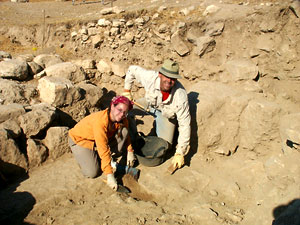 In Field L at the southern lip of the site (David Hopkins and Mary Boyd, supervisors), the members of the cultural immersion team from Wesley Theological Seminary and other tour members (Steve Barbery, Mike Dubbs, Tom Tipton, Jen Harris, Charles Harris, and Henry Hopkins) worked feverishly to find as much as they could before leaving for home on Tuesday. They were able to uncover the upper Hellenistic surface, a water drain, and the tops of the walls belonging to the eastern portion of the Hellenistic farm.
In Field L at the southern lip of the site (David Hopkins and Mary Boyd, supervisors), the members of the cultural immersion team from Wesley Theological Seminary and other tour members (Steve Barbery, Mike Dubbs, Tom Tipton, Jen Harris, Charles Harris, and Henry Hopkins) worked feverishly to find as much as they could before leaving for home on Tuesday. They were able to uncover the upper Hellenistic surface, a water drain, and the tops of the walls belonging to the eastern portion of the Hellenistic farm.
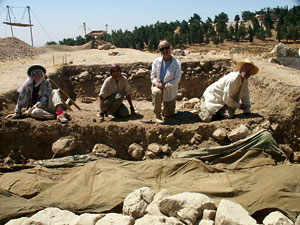 We were sad to see members of the team depart, but a few others have arrived to help keep Field L on the move (Ruth Kent, Azadeh Vafadari, and Ferdinand Regalado). They removed a balk during the last two days of the week, giving us new vistas on the Hellenistic remains.
We were sad to see members of the team depart, but a few others have arrived to help keep Field L on the move (Ruth Kent, Azadeh Vafadari, and Ferdinand Regalado). They removed a balk during the last two days of the week, giving us new vistas on the Hellenistic remains.
But we also found small items, including another coin in Field L, scores of stone grinding tools, several figurines, lots of short metal wire fragments, a bronze needle, a beautiful small ivory spindle whorl, a curious miniature bowl, and part of a crude unfired figurine from the palace/temple. The most unique find was the bottom of a rhyton made in the shape of a horse head. A rhyton is a large cup for drinking wine that has an animal head at the bottom with a hole coming out the mouth. If unstopped, the wine would pour out the hole at the bottom. Drinkers would put their thumb on the hole, fill the large cup with wine, hold the vessel above their head, and then drink the wine as it poured out. It is typical of the Persian period.
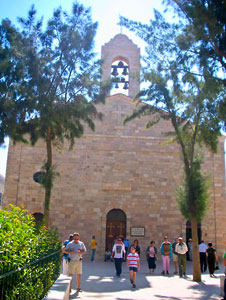 We also traveled a lot last weekend. On Saturday, many in the group toured the great sites along the Kings' Highway south of Amman. We stopped at Madaba to see several of the Byzantine church mosaics there, including the famous Madaba Mosaic Map.
We also traveled a lot last weekend. On Saturday, many in the group toured the great sites along the Kings' Highway south of Amman. We stopped at Madaba to see several of the Byzantine church mosaics there, including the famous Madaba Mosaic Map.
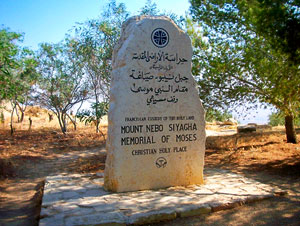 We climbed the ridge of Mt. Nebo gazed upon the same vistas as Moses when he viewed the Promised Land, and saw the mosaics in the Byzantine church there. We drove along the spectacular crest of the highlands above the drop-off to the Dead Sea to get to Machaerus, one of the great hill-top palaces of Herod the Great where John the Baptist lost his head.
We climbed the ridge of Mt. Nebo gazed upon the same vistas as Moses when he viewed the Promised Land, and saw the mosaics in the Byzantine church there. We drove along the spectacular crest of the highlands above the drop-off to the Dead Sea to get to Machaerus, one of the great hill-top palaces of Herod the Great where John the Baptist lost his head.
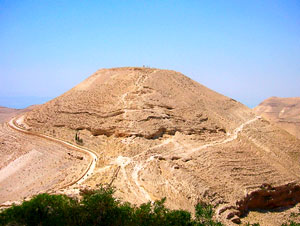 We drove to Dhiban (biblical Dibon), site of the famous 19th-century discovery of the 9th-century BC Moabite Stone, the largest monumental inscription from Jordan and then toward the desert highway to Lahun and Umm ar-Rasas. Lahun, with its early Iron 1 settlement incorporating four-room houses like the one at `Umayri, is perched on the precipitous edge of the Middle East's Grand Canyon, the Wadi Mujib (biblical Arnon River).
We drove to Dhiban (biblical Dibon), site of the famous 19th-century discovery of the 9th-century BC Moabite Stone, the largest monumental inscription from Jordan and then toward the desert highway to Lahun and Umm ar-Rasas. Lahun, with its early Iron 1 settlement incorporating four-room houses like the one at `Umayri, is perched on the precipitous edge of the Middle East's Grand Canyon, the Wadi Mujib (biblical Arnon River).
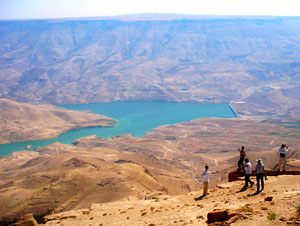 Umm ar-Rasas contains some of the most spectacular Byzantine church mosaics anywhere, as well as towers and domestic houses. It is this site also which reflects the Islamic takeover of the region in the 7th century AD, preserving in the archaeological record evidence of the peaceful coexistence of Christians and Muslims from the beginnings of their encounter. Maybe the modern world could learn something from archaeology after all.
Umm ar-Rasas contains some of the most spectacular Byzantine church mosaics anywhere, as well as towers and domestic houses. It is this site also which reflects the Islamic takeover of the region in the 7th century AD, preserving in the archaeological record evidence of the peaceful coexistence of Christians and Muslims from the beginnings of their encounter. Maybe the modern world could learn something from archaeology after all.
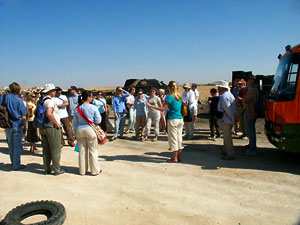 On Sunday, we took another tour that was supposed to be for the teachers, but most of the team joined them. About 40 of us invaded the traditional pottery workshop at Zizia where we were treated to a complete tour of how pottery is made from the gathering of clay to the firing of the vessels in the kilns. As is turns out, this was one of the most popular visits of the touring options we offer during our excavation season - it was extremely educational about ancient pottery manufacture and especially instructive about one of the major industries from the ancient world.
On Sunday, we took another tour that was supposed to be for the teachers, but most of the team joined them. About 40 of us invaded the traditional pottery workshop at Zizia where we were treated to a complete tour of how pottery is made from the gathering of clay to the firing of the vessels in the kilns. As is turns out, this was one of the most popular visits of the touring options we offer during our excavation season - it was extremely educational about ancient pottery manufacture and especially instructive about one of the major industries from the ancient world.
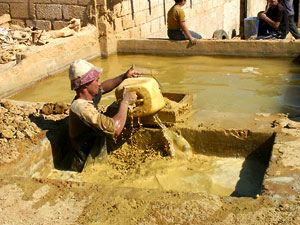 |
|
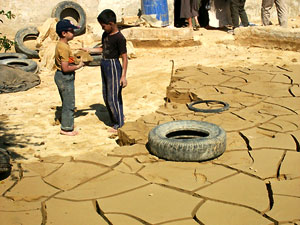 |
|
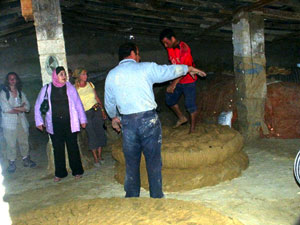 |
|
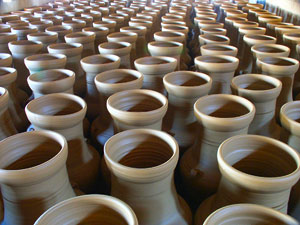 |
|
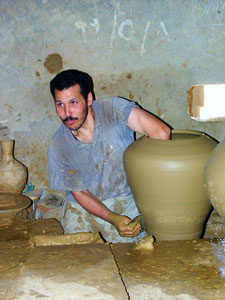 |
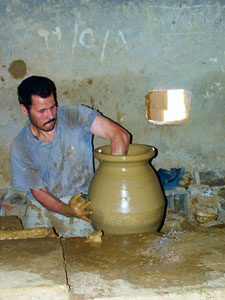 |
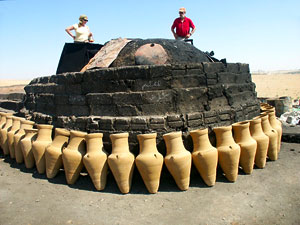 |
|
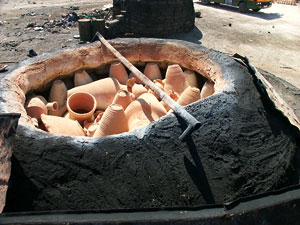 |
|
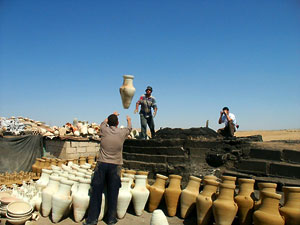 |
|
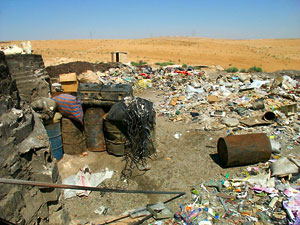 |
|
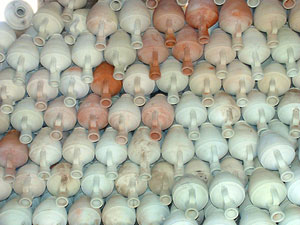 |
|
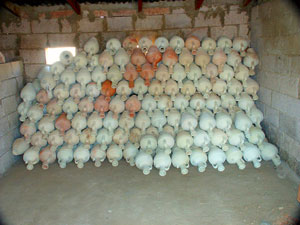 |
|
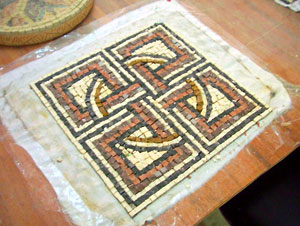 We then went on to Madaba where we saw how mosaics were made and had time to shop in this interesting small city of Christians and Muslims. The women who weave carpets at the Beni Hamida Center near Machaerus probably still don't know what hit them when 40 of us then showed up at their visitor center, saw how they made the carpets from gathering the wool to weaving, and then purchased several hundreds of dinars worth of carpets.
We then went on to Madaba where we saw how mosaics were made and had time to shop in this interesting small city of Christians and Muslims. The women who weave carpets at the Beni Hamida Center near Machaerus probably still don't know what hit them when 40 of us then showed up at their visitor center, saw how they made the carpets from gathering the wool to weaving, and then purchased several hundreds of dinars worth of carpets.
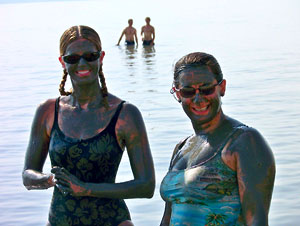 On Friday night a group descended the 1500 meters (about 4500 feet) to the Dead Sea, braving the 100+ degree F temperatures of the Jordan Valley. They went to a resort by the Dead Sea. Here they enjoyed several pools and floated on the water of the Dead Sea, covered themselves in locally dug black mud (it's supposed to be medicinal), showered to get rid of all the salt, and celebrated with a buffet meal before ascending into the cooler temperatures of the highlands once more.
On Friday night a group descended the 1500 meters (about 4500 feet) to the Dead Sea, braving the 100+ degree F temperatures of the Jordan Valley. They went to a resort by the Dead Sea. Here they enjoyed several pools and floated on the water of the Dead Sea, covered themselves in locally dug black mud (it's supposed to be medicinal), showered to get rid of all the salt, and celebrated with a buffet meal before ascending into the cooler temperatures of the highlands once more.
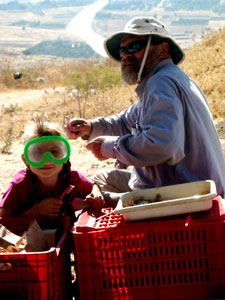 It was a week of vistas. New vistas at the tell (and new ways of viewing; grand vistas at the Wadi Mujib and Mount Nebo; and educational vistas at a variety of workshops.
It was a week of vistas. New vistas at the tell (and new ways of viewing; grand vistas at the Wadi Mujib and Mount Nebo; and educational vistas at a variety of workshops.
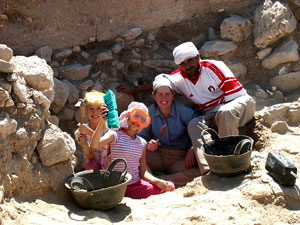 |
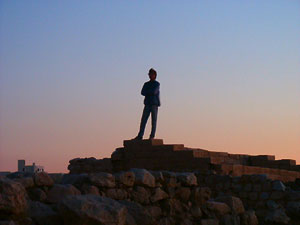 |
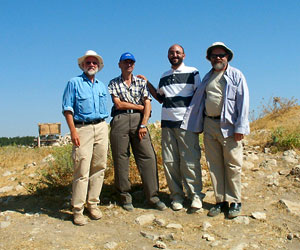 |
Postscript on the situation across the river: We really have nothing to report on changes in life in Jordan for us due to the raging battle and bloodletting to our west, as nothing has changed for us. We keep working away in a hospitable environment, praying for sane minds to prevail and peace to return to the region, a condition much more prevalent throughout history than the stereotypical picture of constant conflict.
Returnees to their homes as of this point in our season: Several of our team members have returned home from their summer adventure excavating in Jordan, having contributed significantly to our archaeological research. We miss them already and want to thank them for giving weeks of their lives to the cause of recovering Jordan's cultural heritage:
- Tom Tipton
- Steven Barbery
- Mike Dubbs
- Charles and Jen Harris
- Henry Hopkins
- Laura King
- Anneliese Weiss
- Allison Hade
- Russ Dedul
- Greg Kremer
Overheard:
"How am I ever going to live this down." - Dave Berge, who never ever misses an appointment or is late, at 6:15 am in the car Larry Herr had to drive back to camp in order to bring him to work late because he missed the wake-up bell at 4:15 - by press time, he had not yet lived this down.
"Who, us? Happy that our Field Supervisor is inexplicably late? No way!" - Field H personnel enthusiastically awaiting the arrival of Dave Berge.
"If you take the medicine for your eye, it should get better soon. Come back in a few days for me to check on how you are doing." - physician at an Amman eye hospital, to Doug Clark who had contracted a viral eye infection which affects lots of people around Amman. Cost of clinic visit, eye examination and follow-up - JD 15 (=$21).
"If you take the medicine for your eye, it will take about seven to ten days to get better. If you don't take the medicine, it will take about seven to ten days to get better." - Mohammad, the cook.
[Photos by Douglas Clark unless otherwise attributed]
